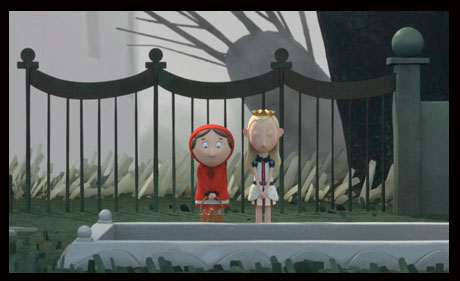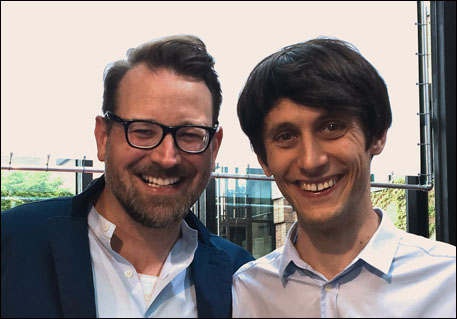
Directors Jan Lachauer and Jakob Schuh are veterans when it comes to the Academy Awards Animated Shorts category. Schuh and partner Max Lang were nominated back in 2009 for The Gruffalo and Lachauer and Lang teamed-up on 2012 finalist, Room on the Broom. The pair, again working with Magic Light Pictures, is part of this year’s Oscars competition with Revolting Rhymes.
Jackson Murphy: “Revolting Rhymes” is based on a 1981 book of poems by the legendary Roald Dahl that features six separate classic Fairy Tale stories that are twisted-up. With your short you’ve intertwined a few of them, essentially creating new stories. Was that the goal going in?
Jan Lachauer: Not at all. When producer Martin Pope approached us with Dahl’s collection of these poems he deliberately didn’t give us a specific briefing or target regarding a format etc, apart from finding what we thought would be a fitting adaptation of these lovely, very modern poems. But when we first read the book we both got the feeling that there was a strong connection between these individual tales. There’s not only the underlying tonality of the narration but also shared themes of empowerment and non-traditional gender roles that made us think this must be taking place in a conjoined universe, each poem highlighting a different aspect of said world.
Jakob Schuh: In the book, Dahl’s narration itself has a very distinct voice. It’s hilariously opinionated and has strong thoughts about the traditional morals of fairy tales. That tone, the urge to set things right, was another thing all the stories had in common. So, besides conjoining the tales, it also felt right to create a character, a stand-in for Dahl so to say, to tell them all. That’s how our narrator, the charismatic Wolf, ultimately played by the equally charismatic Dominic West, was born.
JM: This story revolves around two iconic Fairy Tale characters: Snow White and Little Red Riding Hood. Why was having female protagonists important to you?
JL: Snow White and Little Red Riding Hood are obviously female protagonists both in the classic fairy tales and in Dahl’s poems, so we can’t take credit for this. However, and that’s so wonderful about Dahl’s version of these stories, these protagonists don’t often appear as personalities beyond their traditional roles. Even in modern fairytale adaptations these characters tend to grapple in one way or another with the archetypal roles assigned to them in folklore.
Dahl doesn’t do that, he tells their tales as stories of humans, people making decisions, failing, triumphing, almost as if their classic fairy tales never existed. This gives their ultimate empowerment in these stories a very different feeling. Inspired by that approach we felt we should try to expand those characters’ arcs and personalities the way you would in a non-fairytale story. We had the feeling both Little Red Riding Hood and Snow White share very common motives as they’re freeing themselves from their predetermined lives. So we decided to let them cross paths as kids and become friends to go through the hardship of their next ten years together.
JS: The tricky part, however, was to tell the story of their relationship – the heart of the film – without changing or adding to any of Dahl’s original rhymes. This meant that we had to build their relationship completely wordlessly around the existing rhymes, hopefully without the viewer realizing how it’s done.

JM: You’ve already won a BAFTA Children’s Award for “Revolting Rhymes”. Congratulations. Most award competitions, including the Academy Awards, are judged by older voters. How does it feel to know what you’ve created has had a major impact on the younger audience as well?
JS: While we were making the film our aim was to create something the young Dahl fan could appreciate as much as an adult viewer. As for our young audience, we’ve been to a lot of theatrical screenings with up to 2,500 kids in a room and it was just delightful to see the unfiltered emotional reactions during those presentations. That’s always one of the nicest rewards after having completed the marathon of a project like this.
JL: Regarding an audience that looks at these stories with a more adult mind, the equivalent would obviously be to read up on the thousands of comments posted about the film on social media. There’s some really honest opinions and clever interpretations of sometimes quite specific aspects of the story out there. It’s just great to read those and see that the audience actually gets what we wanted to tell here and that they care for the characters we’ve created.
JM: Jakob, you co-directed “The Gruffalo” and Jan, you co-directed “Room on the Broom” – both delightful animated shorts and previous Oscar nominees. What was the collaboration process like for “Revolting Rhymes”?
JS: This was our first co-direction together, but we’ve been friends and colleagues for almost 15 years. Our collaboration on this film went through different phases, which sort of built on each other. We started out working as just a duo during the months of writing. Adapting the separate poems into one joint narrative turned out to be a lot trickier than we’d anticipated, and solving that riddle made for a really good basis regarding a shared understanding of what exactly we would set out to do. Then, as the production gains speed and size you get pulled apart more and more, just because there’s too many questions to be answered on any given day. But if you’ve done your homework during the writing and the storyboarding you become interchangeable with your co-director in regards to who answers any given question your team might have. That became especially important as we started working with teams on two different continents. Oftentimes one of us had to be in South Africa while the other one was wrangling the team in Berlin. At that point we became quite adamant that our schedule had built-in at least half an hour of time every day where we could skype with each other without any team member in the room, just to synchronize on where our brains were.
JM: What kinds of research of the original versions of these classic stories did you do to get some of the visual and dialogue references?
JL: In the very beginning we consulted the original versions of the fairytales and their different iterations over the centuries, just to make sure we knew these well and knew precisely what Dahl had changed. But apart from that there wasn’t much fairytale research outside of the Dahl and Blake versions of these tales.
JM: The voice cast is terrific, especially Dominic West as the Wolf.
JS: Dominic is amazing. He did such a wonderful job in giving the wolf the ambiguity we wanted him to have. We had the feeling he himself also enjoyed balancing the mysterious, threatening, and charming aspects of his voice to find this character. Generally we were really lucky to work with this wonderful cast. It’s always a huge inspiration to give the characters you’ve been working on for quite awhile their final voices.

Directors Jacob Schuh and Jan Lachauer
JM: After I finished watching it, I felt like I should start rhyming everything I say. Does a largely all-rhyming script make the storytelling more challenging?
JL: Having done other all-rhymed productions before it didn’t feel that new to us to work like this. We already knew the challenges around adapting a rhymed book and actually became more and more excited about Dahl’s incredibly funny lines the more we worked with them. The great thing on this project compared to the ones before was that we had so much text to work with that it never felt like we had to stretch anything, which sometimes can be difficult when you have to make sure the rhymes don’t fall apart. The challenging bit was obviously that in intertwining the separate poems we added a lot more story to this than we did with our previous films, while at the same time, obviously abstaining from trying to add new verses to Dahl’s genius poems.
JM: We’ve seen Roald Dahl works on the big screen numerous times before with successful versions of “Charlie and the Chocolate Factory”, “Fantastic Mr. Fox”, “James and the Giant Peach”, “Matilda” and most recently “The BFG”. Why do you think his stories continue to have such universal appeal?
JS: The great thing about Roald Dahl is, that despite being known for his mischievous worlds, he never does anything gratuitously. He shows the reader the dark sides but always respects his protagonists. He uses their perspective – often the perspective of children in an adult world or in our case of fierce young women in a man’s world – to describe a ruthless and irresponsible universe to revolt against. By not shying away from a certain harshness he never becomes moralistic, while still having a very clear view on values he held dearly. It’s a deeply sympathetic way of telling stories.
- INTERVIEW: “Inside Out 2” Director And Producer On Pixar Sequel - April 16, 2024
- INTERVIEW: “Puffin Rock And The New Friends” And 25 Years Of Cartoon Saloon - April 10, 2024
- INTERVIEW: “Chicken For Linda!” Directors On Annecy Winning Feature - April 9, 2024


 February 25th, 2018
February 25th, 2018  Jackson Murphy
Jackson Murphy  Posted in
Posted in  Tags:
Tags: 






